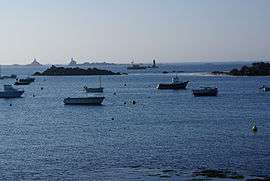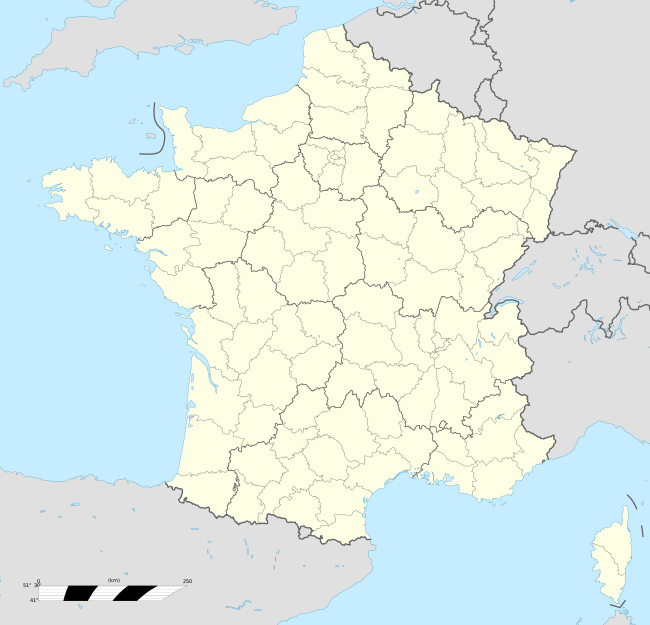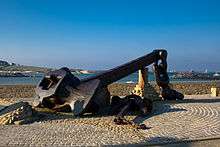Ploudalmézeau
Ploudalmézeau (Breton: Gwitalmeze) is a commune in the Finistère department of Brittany in north-western France.
Ploudalmézeau Gwitalmeze | |
|---|---|
 A view of the sea, at Portsall | |
.svg.png) Coat of arms | |
Location of Ploudalmézeau 
| |
 Ploudalmézeau  Ploudalmézeau | |
| Coordinates: 48°32′28″N 4°39′22″W | |
| Country | France |
| Region | Brittany |
| Department | Finistère |
| Arrondissement | Brest |
| Canton | Plabennec |
| Intercommunality | Pays d'Iroise |
| Government | |
| • Mayor (2014–2020) | Marguerite Lamour |
| Area 1 | 23.18 km2 (8.95 sq mi) |
| Population (2017-01-01)[1] | 6,297 |
| • Density | 270/km2 (700/sq mi) |
| Time zone | UTC+01:00 (CET) |
| • Summer (DST) | UTC+02:00 (CEST) |
| INSEE/Postal code | 29178 /29830 |
| Elevation | 0–86 m (0–282 ft) |
| 1 French Land Register data, which excludes lakes, ponds, glaciers > 1 km2 (0.386 sq mi or 247 acres) and river estuaries. | |
The village and small port of Portsall is part of the commune. Portsall is known for the Amoco Cadiz oil spill.
International relations
It is twinned with Cullompton, Devon.
Population
Inhabitants of Ploudalmézeau are called in French Ploudalméziens.
| Year | Pop. | ±% |
|---|---|---|
| 1793 | 2,701 | — |
| 1800 | 2,906 | +7.6% |
| 1806 | 2,738 | −5.8% |
| 1821 | 2,881 | +5.2% |
| 1831 | 3,023 | +4.9% |
| 1836 | 3,085 | +2.1% |
| 1841 | 3,209 | +4.0% |
| 1846 | 3,234 | +0.8% |
| 1851 | 3,219 | −0.5% |
| 1856 | 3,220 | +0.0% |
| 1861 | 3,267 | +1.5% |
| 1866 | 3,252 | −0.5% |
| 1872 | 3,148 | −3.2% |
| 1876 | 3,341 | +6.1% |
| 1881 | 3,240 | −3.0% |
| 1886 | 3,205 | −1.1% |
| 1891 | 3,286 | +2.5% |
| 1896 | 3,305 | +0.6% |
| 1901 | 3,436 | +4.0% |
| 1906 | 3,465 | +0.8% |
| 1911 | 3,725 | +7.5% |
| 1921 | 3,977 | +6.8% |
| 1926 | 3,946 | −0.8% |
| 1931 | 3,867 | −2.0% |
| 1936 | 3,802 | −1.7% |
| 1946 | 4,142 | +8.9% |
| 1954 | 4,177 | +0.8% |
| 1962 | 4,190 | +0.3% |
| 1968 | 4,297 | +2.6% |
| 1975 | 4,464 | +3.9% |
| 1982 | 4,771 | +6.9% |
| 1990 | 4,874 | +2.2% |
| 1999 | 5,009 | +2.8% |
| 2008 | 6,070 | +21.2% |
Breton language
In 2008, 11.69% of primary-school children attended bilingual schools, where Breton language is taught alongside French.[2]
Amoco Cadiz oil spill

Amoco Cadiz anchor in Portsall
On 16 March 1978, Amoco Cadiz, a very large crude carrier (VLCC), owned by Amoco, split in three after running aground on Portsall Rocks, 5 km (3.1 mi) from the coast of Portsall, resulting in the largest oil spill of its kind in history to that date.[3]
gollark: I wonder if we can add that to <#216575831986667523>.
gollark: You're not thinking evil enough.
gollark: Enterprise licensing: because big companies turn evil fast.
gollark: Works for me too now.
gollark: Nope, that doesn't work.
References
- "Populations légales 2017". INSEE. Retrieved 6 January 2020.
- Ofis ar Brezhoneg: Enseignement bilingue (in French)
- Auke Visser (26 August 2010). "Amoco Cadiz". International Super Tankers. Archived from the original on 4 March 2012. Retrieved 9 September 2010.
- Mayors of Finistère Association (in French)
This article is issued from Wikipedia. The text is licensed under Creative Commons - Attribution - Sharealike. Additional terms may apply for the media files.